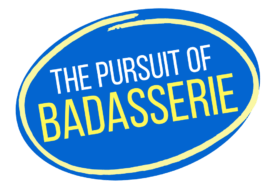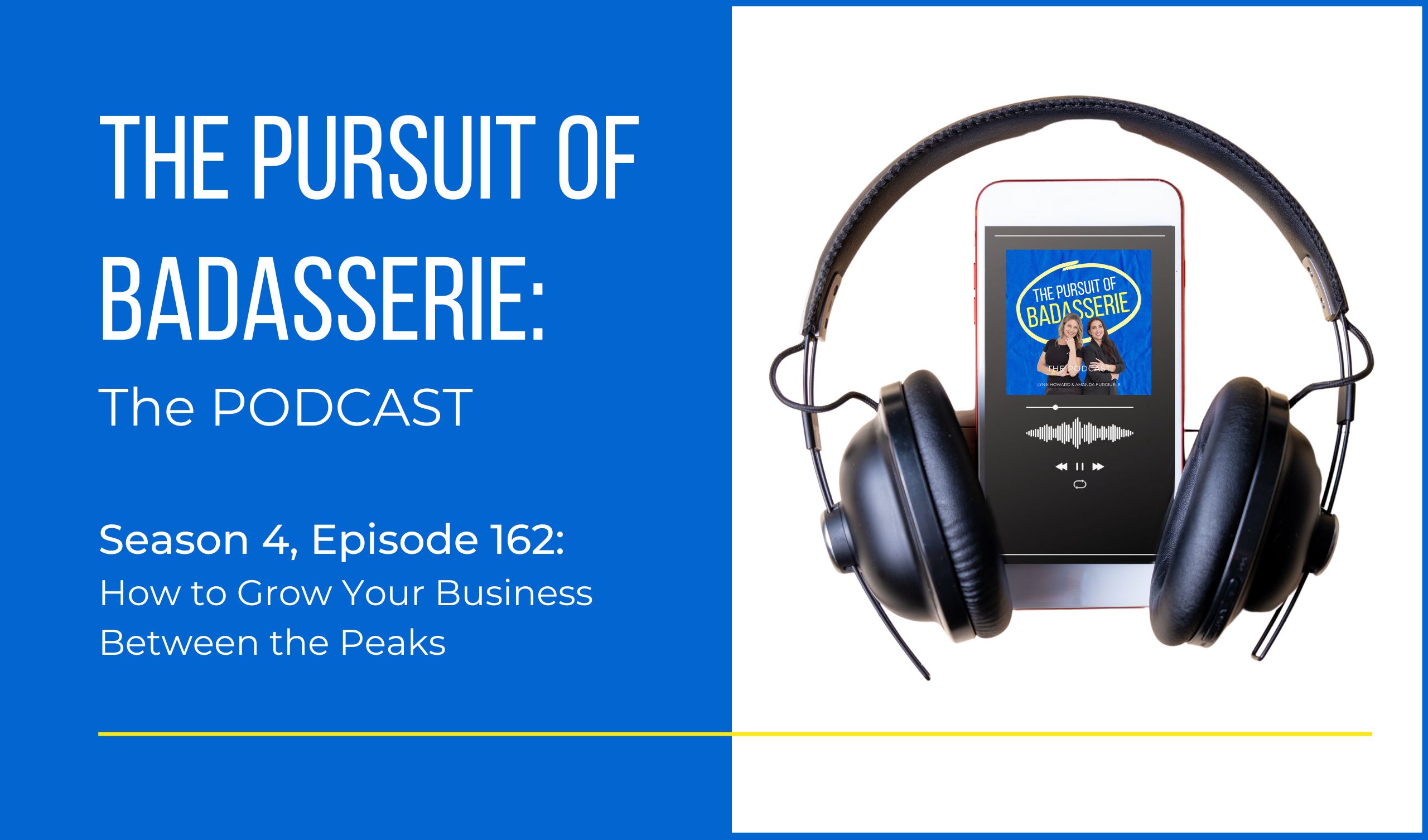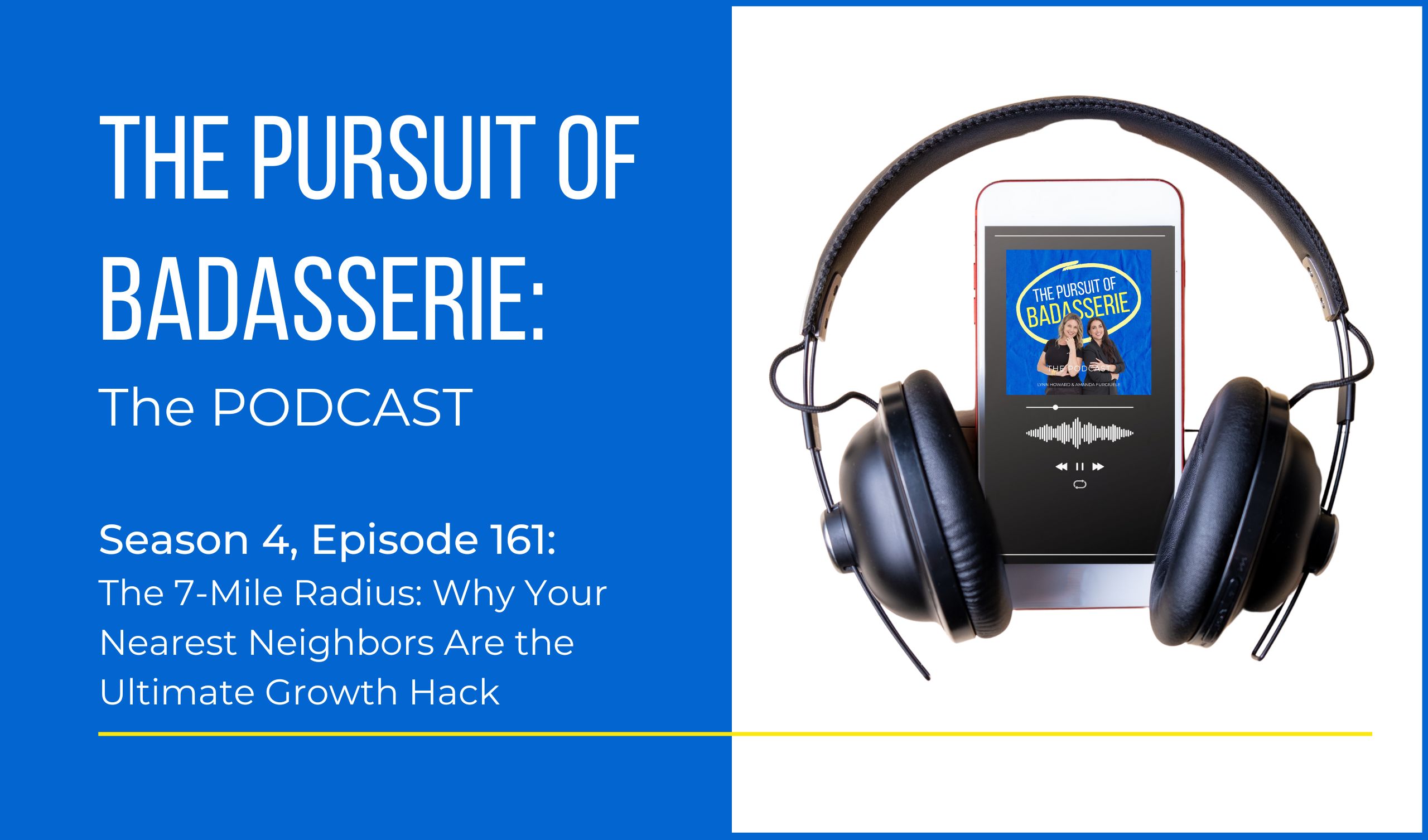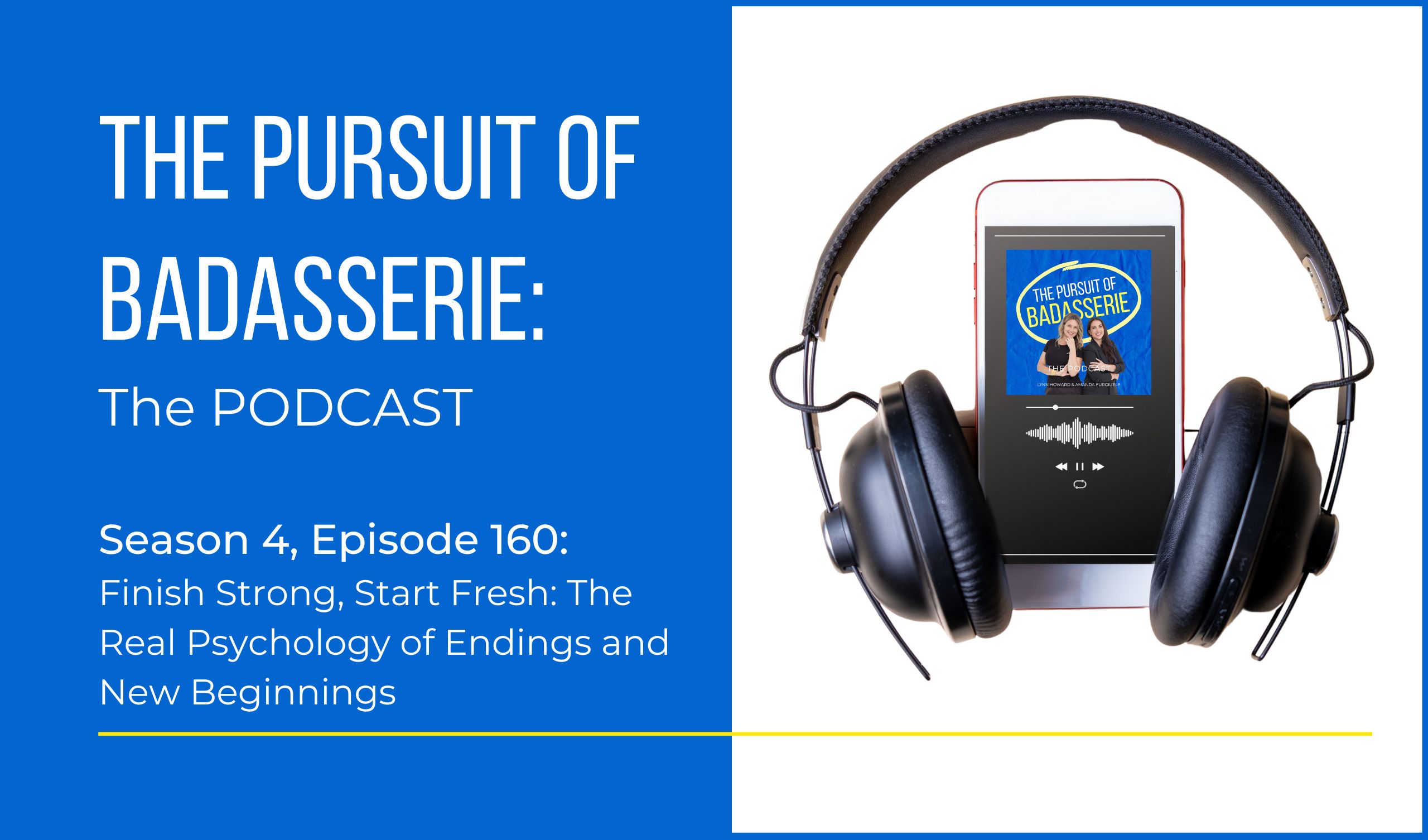Episode 155: Sales Cycles Demystified: How to Predict Revenue and Close More Clients
Are you winging it in sales and hoping for the best? In this episode of The Pursuit of Badasserie, we break down sales cycles and how understanding them can make your revenue more predictable and your business more efficient.
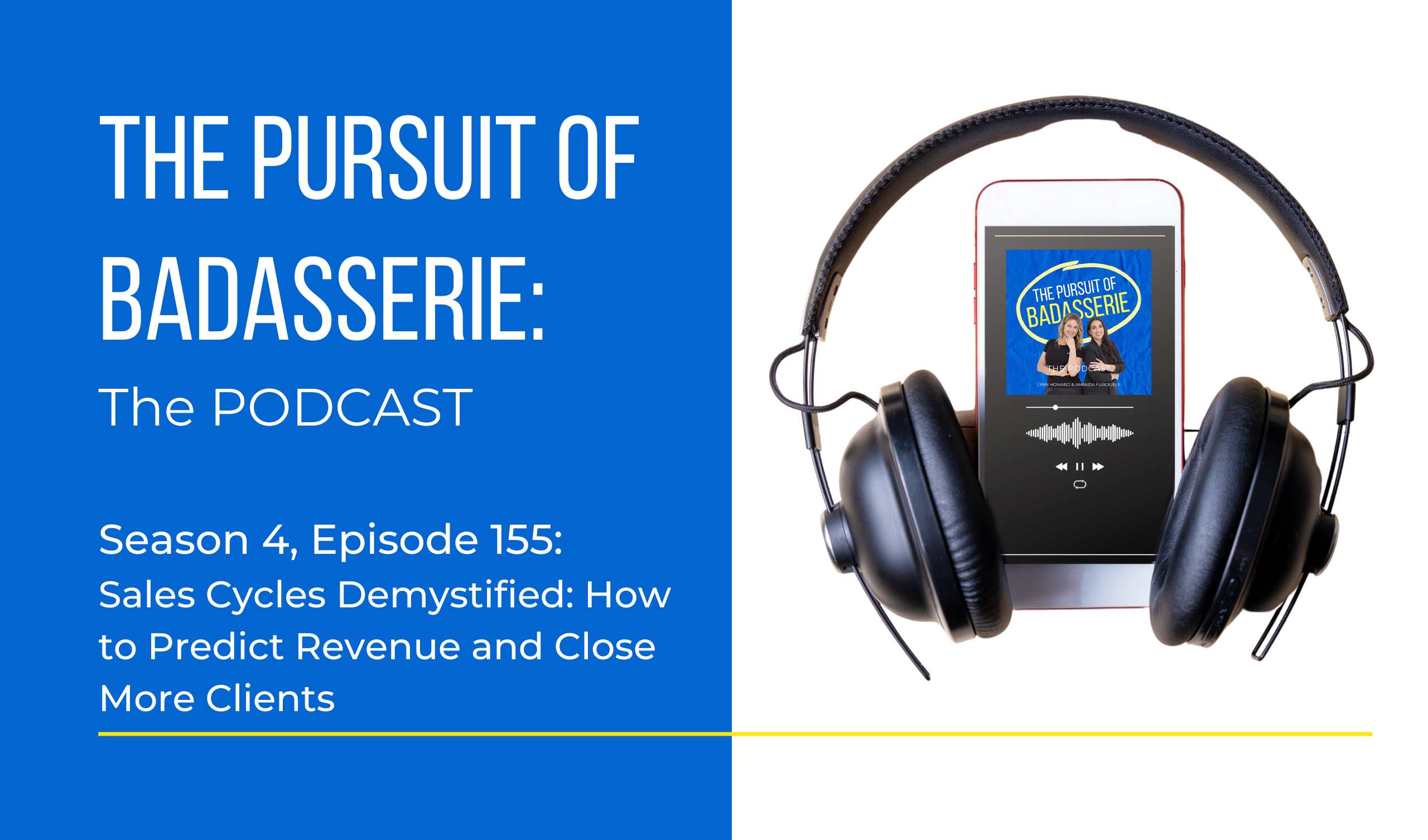
You’ll learn:
- What a sales cycle really is—and why most business owners overlook it
- The key stages of your sales cycle: lead generation, qualification, nurturing, pitching, closing, and follow-up
- Common mistakes that sabotage sales, including not asking, overcomplicating, or assuming “no” is final
- How tracking and analyzing your cycle can fix leaks and improve conversions
- Why sales isn’t pushy or sleazy—it’s essential for keeping your business alive
If you want to stop guessing and start closing consistently, this episode is a must-listen.
Make sure to subscribe to our YouTube or Spotify and leave us a review!
- Like the show? LEAVE US A REVIEW wherever you listen!
- Have a question? CONTACT US at info@thepursuitofbadasserie.com!
- Want to sponsor us? Find out how HERE.
…
Read the full transcript of this episode below:
Lynn Howard
Hey, I’m Lynn.
Amanda
And I’m Amanda. Welcome to the Pursuit of Badassery, the podcast. You know, we love to talk about sales. about sales.
We love I it so much. We wrote a whole book on it. And today we’re talking specifically about sales cycles.
What is a sales cycle? How does it affect your business? And how can you use it to your advantage?
Lynn Howard
I mean, there’s so many different definitions of sales cycle. There’s the external, so like your industry sales cycle and kind of the ebbs and flows with it.
There’s your internal. And I feel like there’s also like your, so internal in general, annual, we’ll say sales cycle, but then also kind of like your own ebbs and flows, which could be monthly.
It could be quarterly, but sales cycle, it’s a, it’s the process of, of all the sums of the sale and all the different parts of it, but also the incoming and the outgoing, or I should say the, the sale itself.
Amanda
the sales cycle. We’ll back. Yeah. mean, it’s all about taking your prospect from knowing that you exist to giving you money and becoming a long-term, ideally long-term paying customer.
And I think that where people go wrong in a sales cycle is sales cycles to me are what keep your business from feeling like you’re winging it all the time.
Like if you, if you’re in a sales cycle and you know it’s coming, it makes your income more predictable because you know it’s coming up and there are, you know, lead generations and all sorts of things you can do.
But ultimately, if you don’t know that cycles exist in your business and how they exist in your business, then you’re leaving money on the table.
You’re, you’re, you’re making it much more difficult to find predictable income. And it’s going to always feel like you’re winging it in your sales game.
Like you never know where money’s coming from. You never know when it’s going to come. Is this a good month?
Is this a bad month? It’s so knowing what your sales cycle is will help with that churn. It’s going to help you bring people in consistently and month
To understand where they are in their sales cycle, like where they are in the client journey, and how long that takes to close them.
And it’s a lot of things, but ultimately, it’s your prospect journey. Like how, how are you going to close the sale?
You’ve got to, there’s a, there’s a cycle there, even if you don’t acknowledge it. And even if you didn’t consciously make it, there is a sales cycle there.
Lynn Howard
Yeah. Yes, absolutely. Um, so talking about your personal sales cycle, um, it’s really, it’s a system. It’s a process, right?
Your sales process would be a word that we would often use here. And, um, like Amanda said, that it’s from the, when you’re going to conversations or like it’s, it, they are in the market.
And there’s some kind of knowledge of, they might want to purchase your product. There’s a need, um, to the time you close.
And then they go into nurturing or that they’re in a more of a holding nurturing pattern, because they’re not necessarily an immediate in the in the thick of the sales cycle.
But there is a difference also to which they all kind of like stack upon one another like Legos or like a puzzle, like the marketing and prospecting cycles of what we do.
And that feeds your sales cycle, because in my personal opinion, and it depends on who you speak with, when we can separate them, because a lot of times people will blend them, then I feel like they should be separated because otherwise people are saying, well, I’m doing all the sales things, I’m doing all the things that all they’re doing is half marketing and putting posts out there.
And that’s not that’s prospecting that’s building no like trust, but that isn’t like, there’s no awareness. feeling… see Tuesday.
There’s no need, there’s no, um, or creating the need or planting, planting the need, um, or uncovering the need.
There’s none of that. So there’s no conversation. So to, to me, they’re two separate things, but, um, yeah, it’s, it’s a system.
And if your sales process or sales cycle is willy nilly, um, or just chaotic, you’re not going to get as much purchases, um, and then they’re not going to become your client.
Amanda
Yeah. And I think, I think recently, like in the last say 20 years, just to keep myself the space for it.
I think they’re, they’re not linear anymore. So with the onslaught of online businesses and the way, like the way social media works, like people can bounce around and it can happen very quickly.
so these sales cycles don’t take as long in a lot of cases. Yeah. to things at such a rapid speed.
If I say something randomly in passing, an ad’s going to pop up on my phone that same day, and then I’m going to see 15 Instagram stories on it the next day.
So things are happening a little bit faster. So the sales cycles can change very quickly, but I think ultimately there are stages.
And we’ve talked about it a little bit here, but stages of the sales cycle. So you’ve got your, your lead generation, your prospecting, like just looking for customers.
Lynn Howard
That’s kind of like looking out and then you’ve got to qualify them.
Amanda
Like, are they a good fit? Are they, are you the solution for their problem? Are they making enough money to afford?
Like if I’m Louis Vuitton, I’m not going to be marketing to somebody who’s in a lower income bracket. So are they going to, you have to qualify them and then you’re going to nurture them.
You’re building trust. You’re, you know, looking at their objective objections. You’re showing the value of what you have. So there you’ve got lead generation, you’ve got qualification.
Then you’re going to nurture them because there’s no point. Nurturing somebody who’s never going to buy your product because they don’t qualify.
And then it’s the making the offer. It’s the sales email. It’s the proposal. It’s the pitch. It’s all those things.
Then you’re trying to close them. And then whether or not you close them, there’s still follow-up or retention. I mean, if you close them, obviously it’s retention, but there’s still going to be follow-up after that.
So that’s like your sales cycle in a nutshell. So when you’re looking at your sales cycle as an individual business, what is fitting into each of those categories?
How are you getting new prospects and new lead generation? How are you qualifying them to make sure that they actually fit into your company values and what you’re offering?
Are they the right fit? Are they part of your ideal clients? Then how are you nurturing them and building trust?
How are you presenting and how often? So, you know, I can’t tell you how many times I’ll ask a client, when’s the last time you sent a sales email?
When’s the last time that you sold something? And they’re like, oh, yeah, well, I mentioned it. It’s I told them I sell that two months ago.
like, people, you got to tell them, you got to talk about, we have a whole podcast on talking about what you sell.
So we’ll be to listen to that one. And then you’re looking to close them. And then there’s follow up.
There’s always going to be follow up, or at least there should always be follow up after the end, at the end of your cycle.
Lynn Howard
I just had that conversation with the realtors this morning. That was their biggest takeaway is following up after the sale.
And following up even not after the sale. You know, I love all of your old school parts. I’ve always, for me, it’s like a simplified version of a sales process or sales cycle would be the source.
So any and all of the sources, all the conversations. So that would be the meeting, the, this, that, the, the ask.
So this is where you’re like, you want to buy or not. And then they go into the back. So if they’re a client.
And obviously the retention side, but it’s a follow-up, right? So the four parts, source, conversations, or I think you call them presentations, ask, and then the follow-up.
And you can break it up into little chunks in between in each of them. But it’s, yeah, you’re prospecting your sources, your legion.
It’s important to know. So, and all I can think about is like when we used to sell franchises, when I was COO and he wanted me to sell franchises via LinkedIn campaign.
And like, it was very clear, two weeks we gave ourselves. There was definitely the prospect or the source, right?
And that was our team doing a campaign and doing some manual and some automated things to gather a certain type of prospect.
And once they agreed to have a. That’s when the conversation started. We had up to four conversations. Mind you, the franchises are at $50,000 USD, but my CEO wanted us to close it within three conversations, but four was the max, but it was all within a two-week span.
If they bought, great, then they went into the next process and then the follow-up and the retention. If they didn’t buy or they didn’t make a commitment after two weeks, then they went into a nurturing.
Um, sequence and that included, um, uh, social media to kind of back it up and different things like that.
And so at the end of the day, if you don’t have, like Amanda said, if you do not have it mapped out, then you are failing yourself and you don’t know, you’re kind of just shooting in the dark.
Um, when problems arise or when you’re not closing, you don’t really truly know your ROI. You’re right. You’re just guesstimating.
Maybe through your calendar, you’re guesstimating, but how much time you’re spending on this, how much time you’re spending on that, you are letting things fall through the cracks if you don’t have that sales process, that sales cycle written out.
And then going back to something I said earlier is there are different versions of the sales cycle, because then if you take like the industry sales cycle and like the ebbs and flows and add that on to already your broken or inadequate kind of sales cycle, not right now, it’s only going to make things more complex and harder because you don’t have a foundation that you’ve built your sales process on.
You’re just willy nilly in it. So when the market crashes or when this happens or when that happens, it’s super important.
Yeah, I’ll let you talk because I want to come back to the follow up.
Amanda
No, you know, I think that along those lines that track.
Lynn Howard
Tracking matters.
Amanda
You have to know what your cycle is because how are you going to know where they’re falling off? Are they falling off in the prospect stage, in the building trust stage, or are they falling off in the close?
How can you fix the leaks if you don’t know where they’re coming from, which pipe is leaking? So knowing what’s happening and tracking all that information can make a huge difference because if they’re going all the way through your sales cycle and then they’re bailing out at the close, then you know that you need to fix the close.
If they’re bailing out in that first email of the welcome sequence, then that’s where you need to be adjusting things and then you see how it trickles down.
But if you don’t track it, you’re just guessing. You’re always guessing. It’s always just like, I don’t know what happened.
I don’t know why they didn’t sign on. And I think that’s always really surprising to me when I’ll ask a client, OK, well, what was their objection?
Like, what was the reason that they said they didn’t want to do your offer? And they’re like, well, I didn’t even ask.
Like, don’t know why they didn’t close. I don’t know what the reason is. I don’t know where they fell off in the cycle.
And that’s information that you can use to your advantage. Because if you know the common objection, if you know what the sticking point is on your offer, that can be part of helping your sales cycle regenerate.
If you know that everybody always falls off at this one point, then that’s what you’re fixing. But again, if you don’t know what you don’t know.
You don’t know what you don’t know.
Lynn Howard
I love that you always bring it back to more of an online sales cycle. And it’s funny. It just had an aha moment.
Like the majority of your clients come from that now, except for your brick and mortar. I don’t know about that.
But do you remember the days where it didn’t, it wasn’t so much of the virtual side? And the same things apply.
Like, I think I’m taking more of a position from non-automated and which you want to automate stuff. But more face-to-face.
But I do love that you brought it back. I do want to point out something because you brought it up in like, if they’re falling off on the email where you’re trying to convert them, then, and we actually had this, we have a sales process and email, a sequence, and we have a full sales process, but the email sequence is part of our sales process inside promoting like the BA, the badass amplifier.
And we realized in one of our, one of our launches, we saw, cause we improve, we evaluate every time and we improve it.
Right. Um, and we saw that like 80% were dropping off on this one particular email. I can’t remember if what launch it was for.
I know it wasn’t that long ago. Yeah, it was from Manila, Manila. And so we change, we did a little bit of like evaluation.
So this was the six day live event of like, why would that be happy now? Some of it is our guest.
So, But also it could be getting outside resources, because it was a new market of how to change this around.
So I think that’s really important that you’re asking in a way that your audience needs to hear, but also that you’re building up value that whole time, regardless if it’s on or offline.
But don’t forget to ask, like, so many people do not ask, and this is where you think you asked.
And then you lose them because they feel like, you know, this person’s leading me on like, should I get off the spot type of thing, like pull the trigger already.
And if you’re not asking in a way that they can hear or a way that adds value to them, or if you’re not asking it at all, then, then it’s not going to happen as often.
And so many people forget or hesitate at the ask. So do not forget to ask.
Amanda
I want to go over some of the common mistakes people make in their sales cycle that I think we hear way too often.
And I will say some of them. Number one is not asking, but also assuming that no is the final answer.
And that the second they say no, you try to backtrack, like, oh, I know isn’t the final answer. And no doesn’t mean never.
It just means not right now. I think that’s one that people, at the end of their sales cycle, they assume that no means no forever.
I think people don’t follow up enough. The no following up, generally speaking, it’s probably more now or maybe even less, I don’t know, that sales happen after multiple sales at multiple touch points.
Most people are on impulse buying everything. I mean, this isn’t, you’re not. All at the cash register or buying a stick gum, sales take longer than that.
So most business owners will stop after one or two touch points. They’ll give up at that following up, but I have plenty of evidence that people will buy after five, six, 20, 30 touch points later, they will eventually come back into your system.
Lynn Howard
seven and now it’s double, I think.
Amanda
Yeah, it’s great. Well, because there’s so many, I mean, people are inundated with information now, but it’s five to seven was the old school way.
And I still stick by that. I still, and again, even if they say no, after the seventh, they’re not leaving my CRM.
I’m not never talking to them again.
Lynn Howard
They’re still in there because there’s always that follow-up. they unsubscribe.
Amanda
Unless they unsubscribe, but that’s different.
Lynn Howard
That’s, that’s, that’s a never, that’s a, that’s a no means never.
Amanda
I’m talking about the people who just kind of like sit in there and they’re like, like your stuff every three months, but they never actually buy anything.
Like they’re still in there. I think that’s, and I think over-complicating is another one. Like, and I know. You had a client that was overcomplicating their system and like, it doesn’t always have to be 50 steps just because you like to hear 50 steps.
Maybe somebody else just wants two steps. So I think that’s another big one.
Lynn Howard
Yeah, definitely. I think it, you know, we have to understand our own behavioral style on that and our own nuances.
actually just had this conversation this morning in the Q&A aspect of the training with the realtors, but yeah, that’s what you like, but is that what your clients like?
And, um, yeah, I think also with that, the overcomplication is not having clarity in what you’re selling and the confidence.
So I think those, those C’s again, um, I, I feel like another mistake is people pitch too early. They pounce, uh, yeah.
Yeah. And you know, there is the traditional sales model and then there’s a trust sales model. Não. Right. I think another thing, I want to go back to follow up because that was actually one of the takeaways from the realtors this morning was because we talked a little bit about sales funnel, sales process, cycle, whatever, and that follow up and follow through and like how to do that.
And one of the individuals was like, well, I don’t like the, you know, I avoid the guy when I go to church, the greeter who shakes everybody’s hand.
And I don’t like it when I get the, the email from this company or this company, Hey, it’s your birthday.
It’s too generic. And I was like, wow, I always use my Sephora points during my birthday month. And I love a free Starbucks.
I love a free Starbucks, but I get what he was saying. He’s like, I want it to be more personal.
Great. That’s actually better. But if you’re not doing it, then start somewhere. So if you have to automate it or put it into a system and not always be, because then it becomes expectation ever.
I think, you know, the anniversary of buying the house is a good thing, but. Not every time or whatever, but that follow up, people don’t follow up and you can get a lot of referrals, you can actually get upsells, you can have better retention for that.
That’s part of your sales cycle. That’s part of your client journey as well. But that’s the sales cycle in your client journey, because they’re already your client journey.
And I would also say one other thing, and this drives me effing crazy, and this isn’t just in the sales cycle, but you definitely want to watch it in the sales cycle because with sales cycles, you want to make sure that you’re planting just a bunch of green flags.
The second you start planting little subconscious red flags, it’s going to be harder for you to sell to them.
And one of the things that drives me batshit crazy is industry jargon or certain language that is going to make your client, and that goes to the clarity point as well, but that makes your client literally scratch your head and be like, WTF, what was that?
I don’t understand, and that’s pointing, planting little red flags that’s going to hurt your, hurt your conversion, period.
Amanda
Yes, it’s definitely the tighter and clearer your sales cycle, the more predictable your revenue is going to be. And I want to say one thing that I feel like every person I’ve ever talked to about sales who wasn’t a salesperson, just like normal business owners, you’re not being pushy.
OK, pushing, like getting somebody to go through your sales cycle isn’t pushy. You’re just guiding them through the decision that they’re going to make anyway, whether they make it with your company or a different company.
If they have a problem and you’re the solution, they’re going to make that decision, whether they do it with you or somebody else.
So you’re not being pushy. You’re guiding them on a decision. And it’s only sleazy if you are sleazy sales.
It’s not sleazy sales. It’s not pushy. That is if you are pushy, if you are sleazy and you mentioned it before.
Like, don’t jump for the sale. That’s what makes it feel. Pushy. If you’re going to never, like not try to build any trust, not try to see if they even qualify, you’re just trying to like get the sale.
That’s what’s pushy. That’s what’s sleazy and creepy. Sales is not creepy. It is essential for your business. It is what makes your business keep going.
So if anybody thought that at any point during this podcast, I need you to get it out of your head because sales is essential.
It is the lifeblood of your company. And it’s only creepy if you are.
Lynn Howard
Yeah. A couple more that I just thought of that I can’t believe I didn’t say this versus when you ask for the sale, you shut your mouth.
Like that’s a big mistake. People just ramble on. They continue. No, ask for the sale, shut your mouth. And I would say this is obviously more like if I’m trying to sell Amanda and asking her for the, the, the yes.
But there’s also ways to do this virtually. Like don’t, don’t over explain. Don’t justify. Don’t Don’t ramble through it.
You need to be clear and just like ask for the sale and be direct. Don’t just ramble.
Amanda
Don’t need every tiny little bit of information about your company and your product and your services forever in order to make their decision.
Lynn Howard
They really don’t. don’t project. I think that that’s another mistake. A lot of times people say, oh, they can’t afford it or they’re too busy for this or they’re, you know, they’re already this.
Why are you projecting? Let them say no. Let them say yes. Let them say not now. Let them ask the questions.
But I think that those, yeah, I’d like kick myself in the if I didn’t say those before we ended up.
Amanda
You know, and one more.
Lynn Howard
We could talk about sales forever.
Amanda
the book. I just, it came up on a client call this morning. Like just because they say a common objection doesn’t mean that that’s really what’s happening.
Like saying like, I don’t have time and I don’t Have money is what everybody says. It’s like a reflex almost.
It’s like when you, can you take the call? They’re like, oh, you know, I’m actually, I’m busy right now.
Like, that’s a reflex. That’s not actually what’s happening. So trying to break down their objections and break down that part of the cycle.
Again, that’s part of looking at your analytics and tracking what it is they’re actually objecting to. Because if you don’t really ask the questions, you’re never going to know the answer.
You’re always going to be assuming everything. And that’s really nice.
Lynn Howard
It’s going to work. Yeah. Well, I mean, objections are just, they’re so knee jerk more so now than what they were because people are just bartered and overstimulated period.
So man, we could go on forever and ever.
Amanda
We could go on for a long time. We do love sales.
Lynn Howard
Yeah. So yeah, we’d love to know like what parts that you feel like we’re missing some of the things that you would add to this podcast.
Amanda
Leave your comments below. And And We have a copy of our sales book, Pursuit of Badasserie, the sales edition
If you have more questions about sales, we are happy to answer sales questions. So if you have a question about sales, drop it.
Lynn Howard
We’ll tell you a thing or two. Absolutely. Share this with somebody in your network who you feel would want to hear this particular podcast.
And again, make sure you’re hitting that subscribe button. We release new podcasts every single week on different topics. And if there’s a topic that you want to hear, go ahead and also DM us.
We will make sure, even if it’s not in our wheelhouse, we’ll bring somebody on who could talk about it.
Amanda
So. All right. Until next time.
Lynn Howard
Get after it.
